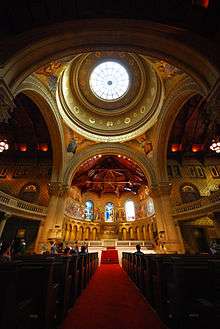Stanford Memorial Church
Coordinates: 37°25′36″N 122°10′14″W / 37.4268°N 122.1705°W

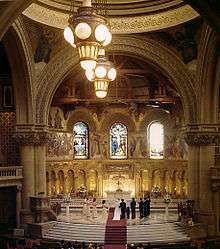
Stanford Memorial Church (also referred to informally as MemChu)[1] is located on the Main Quad at the center of the Stanford University campus in Stanford, California, United States. It was built during the American Renaissance[2] by Jane Stanford as a memorial to her husband Leland. Designed by architect Charles A. Coolidge, a protégé of Henry Hobson Richardson, the church has been called "the University's architectural crown jewel".[3]
Designs for the church were submitted to Jane Stanford and the university trustees in 1898, and it was dedicated in 1903. The building is Romanesque in form and Byzantine in its details, inspired by churches in the region of Venice, especially, Ravenna. Its stained glass windows and extensive mosaics are based on religious paintings the Stanfords admired in Europe. The church has five pipe organs, which allow musicians to produce many styles of organ music. Stanford Memorial Church has withstood two major earthquakes, in 1906 and 1989, and was extensively renovated after each.
Stanford Memorial Church was the earliest and has been "among the most prominent" non-denominational churches on the West Coast of the United States.[4] Since its dedication in 1903, the church's goal has been to serve the spiritual needs of the university in a non-sectarian way.[3] The church's first chaplain, David Charles Gardner, began a tradition of leadership which has guided the development of Stanford University's spiritual, ethical, and academic relation to religion. The church's chaplains were instrumental in the founding of Stanford's religious studies department, moving Stanford from a "secular university"[5] at the middle of the century to "the renaissance of faith and learning at Stanford"[6] in the late 1960s, when the study of religion at the university focused on social and ethical issues like race and the Vietnam War.
History
Early history

Stanford Memorial Church is located at the end of the mile-long axis of Stanford University, visible from a distance; the main vista begins at the main entrance, continues to Palm Drive, traverses "the Oval" (a large oval lawn), enters the Main Quad (the core of the university), and finally crosses Memorial Court and the Inner Quad courtyard.[7] The church was commissioned by Jane Stanford (1828–1905) as a memorial to her husband, Leland Stanford (1824–93).[8][note 1] The Stanfords had intended that a church should become "the centerpiece of the university complex".[9] They were deeply religious, and for their day and social standing, "open-minded ecumenicalists",[10] so they included in the university's original charter that a church built on campus should be a "nondenominational—if essentially Protestant—house of worship".[10] They had traveled Europe for many years, visiting churches, museums, and notable buildings and finding inspiration for the architecture of both the university and church.[8] They received their greatest inspiration from the Piazza San Marco in Venice.[7]
During one of the Stanfords' European trips they befriended Maurizio Camerino, an artist with a reputation for producing high-quality mosaics, who was managing the Antonio Salviati studios in Venice. After Leland Stanford's death in 1893, legal disputes tied up the Stanford estate and prevented the completion of the university for several years. When the disputes were settled in Jane Stanford's favor, she was finally able to put into motion her wish for a church.[11] In 1898, she and the university trustees requested design submissions for the church.[12] Once Stanford Memorial Church was ready for decoration, Jane Stanford visited Camerino, who had taken over the ownership of Salvati and Company in 1890, and commissioned him to produce mosaics for the church.[8] Stanford spent two months in Venice, working closely with Camerino and selecting the watercolors he created that were eventually developed into the mosaics. The process of finalizing the designs took several months after Stanford returned home to California, as new paintings and modifications were shipped to her by boat.[13] The art contained in the church "greatly occupied" Stanford; as former chaplain Robert C. Gregg put it, "The structure was to be without flaw".[14] Stanford was determined that the quality of the church's workmanship would equal the medieval churches she had admired in Europe.[14]
Groundbreaking for the church was held in 1899.[9][15] After a delay of almost a year, Stanford Memorial Church was dedicated on January 25, 1903,[12][15] with "impressive ceremonies".[15] Demonstrating Jane Stanford's goal of ecumenicism, Rabbi Jacob Voorsanger of San Francisco's Congregation Emanu-El read the first Bible lesson. The church's pastor, Heber Newton, gave the sermon. A second service was held later that day, and D. Charles Gardner, the chaplain, gave the sermon. Stanford Memorial Church's first christening was held between the two services.[15]
Jane Stanford once remarked: "While my whole heart is in the university, my soul is in that church".[8] She died in 1905, and so did not live to see the damage caused by the 1906 San Francisco earthquake.[8] Her funeral took place in the church, which was called one of her most important accomplishments and "the truest reflection of her visionary leadership",[16] in March 1905. Demonstrating her belief in ecumenicism, clergy from several religious traditions, including a Rabbi, a Presbyterian minister, a Methodist minister, an Episcopal bishop, and a Baptist minister, officiated at the service.[17]
Earthquakes
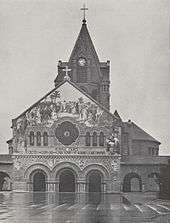
Stanford Memorial Church has suffered two major earthquakes, in 1906 and in 1989. Although extensively damaged, the church was restored after each. The 1906 quake wrecked much of the church, felled the spire, cracked the walls, and "injured beyond repair" the mosaics and Carrara marble statuary in the chancel.[18] The main cause of the severity of the damage was that the church's original construction failed to attach the crossing structure to the surrounding masonry and roof structures.[19][20] The result was that when the church swayed in the earthquake, the crossing structure moved independently from the rest of the building, gouging gaping holes in the roofs over the east and west transepts, the nave, and chancel. The church's original 12-sided, 80-foot spire and its adjoining clock tower above the crossing structure, fell on top of the chancel roof below, destroying the tower dome's "frescoed Victorian interpretation of God's eye—complete with tear—surrounded by cherubs and shooting star".[21] As the roof came down, many of the marble sculptures of the twelve apostles that decorated the altar were also destroyed.[18] The statues, which stood in front of the niches surrounding the altar, were never replaced.[22]
The spire was never repaired and the tower was removed and replaced by a simpler structure; however, the clock was saved and eventually placed in another building on campus, the Stanford Clock Tower.[8][23] University trustees considered re-building the tower, and even looked at possible designs, but eventually chose not to rebuild it because they could not agree on its design.[24] The crossing structure, the only part of the building to remain relatively stable after the quake, also pushed the roof of the nave forward, causing the church's front facade to fall into the Inner Quad courtyard as it broke free,[20] which resulted in the destruction of the entire north face of the building; as Gregg put it, "its wondrous mosaic was blown out and totally destroyed".[8] The only mosaics not destroyed in the quake were the four angels that decorated the crossing dome's pendentives.[22] The back of the church, with several hundred feet of arcades, was also completely leveled because it too was not joined to the rest of the building.[20]
Repairs of the earthquake damage began in 1908, despite misgivings from some university administration regarding its cost.[20] The church and the Old Chemistry building were the only two buildings in the university's Inner Quad that were repaired.[25] The extent of the damage was such that the church had to be completely rebuilt. The entire church, except for its surviving crossing structure and offices, was dismantled stone by stone, which, along with the windows, were labelled and stored.[22] "To assure permanence" in case of further earthquakes, the masonry was anchored to its thick, concrete-reinforced walls. The stones were securely bolted to each other, "making the whole structure practically one massive hollow rock on a great steel foundation skeleton".[18] The tile floor was replaced with cork.[26] The building's crossing received a tiled hipped roof and an oculus, which lit the interior of the church, and was added above the renovated dome, which had a frescoed ceiling decorated with bronze designs as opposed to the gold leaf present before the earthquake.[24] The original rose window above the front facade was replaced with one with a simpler arch shape because it was more similar to the style of the rest of the buildings in the Inner Quad.[20][26]
The dedication, which was engraved in large letters below the facade mosaic, was replaced by a smaller dedication plaque placed at the lower left of the facade, a choice the university alumni magazine called "a tremendous improvement".[26] Camerino's design of the mosaics that were to fill in the empty space created by the removal of the original dedication, which he offered free of charge, were rejected in favor of a simple version created by John K. Branner (son of university president John Casper Branner) in 1914. Camerino, who did not appraise the damage until 1913, restored the interior mosaics. He had saved the original drawings in Venice, so he removed and re-fabricated the chancel mosaic, and redesigned the entire exterior mosaic.[8] The Stanford alumni magazine, in early 1917, after the completion of the interior mosaics, declared the renovation complete, stating that "the church, for almost the first time since it was begun, is finished".[26]
In 1989 the church was damaged again, in the Loma Prieta earthquake. The integrity of the structure remained,[8] but the crossing structure, the only major part of the building that was not damaged in the 1906 earthquake, buckled and caused several stones in the north and west arches to slip as much as 2 inches (5.1 cm).[27] The four mosaic angels in the pendentives, which decorated its high rounded walls directly below the church's dome and served as the setting beds for hundreds of thousands of tesserae, were severely damaged. The angels' damage caused large chunks of mortar and glass to fall to the floor eighty feet below 80 feet (24 m), while other sections "were left hanging by the sheer geometry of their arched shape".[28] An eight-foot mosaic section of an angel's left wing in the church's northeast corner fell 70 feet (21 m) to the floor. Several stones from the east arch wall fell onto pews in the balcony, and the organ-loft railing collapsed inward. Although the damage was minor, the church remained closed until 1992 while restoration, as well as protecting the building from future earthquakes, was carried out. A $10 million fundraising drive was conducted to pay for repairs.[27]
In this restoration the entire crossing was strengthened by bracing it behind the dome and securing it to the superstructure of the building. The roofs, which had not been replaced since 1913, were rebuilt with plywood diaphragms, 30,000 new red clay tiles were installed, and the stones from the decorative arches were reinserted. The wing of the damaged angel was restored;[27] Stanford University hired William Kreysler and Associates to create a new backing system to secure this angel and three other mosaic angels to the base of the dome.[28][note 2] The renovators found a piece of the original mosaic from the vestibule wall, which had a Chi Rho design, in the foundation, and inserted it into the Communion Table in the chancel, linking the current building with the pre-1906 church.[29] The Victorian chandeliers were repaired and rewired, and the transept balconies, which had been closed for twenty years because they were declared unsafe, were reopened, after the false doors on the south side of each balcony were replaced by emergency exits and connected to existing staircases on the other side of the wall. Stanford Memorial Church was rededicated by chaplain Robert C. Gregg on November 1, 1992.[30]
Influence
Gifted as a preacher as well as a jazz pianist, [B. Davie] Napier turned the chapel into what some regarded as Christian theater—the introduction of jazz and other types of experimental worship as well as provocative preaching. Suddenly a jam-packed Memorial Church became the fashionable place for undergraduates to congregate on weekends.
Stanford professor Dr. Van Harvey[6]
According to Stanford professor Van Harvey, Stanford "had the reputation of being a completely secular university" before the 1950s,[5] calling the period a "background of aggressive secularism and the almost complete neglect of the academic study of religion".[5] In 1946, Merrimon Cuninggim, a visiting chaplain at Stanford Memorial Church, criticized the serious lack of religious and spiritual resources available at Stanford for its students and criticized the university's lack of academic courses offered in the study of religions. Cuninggim insisted that the university's administration and trustees were responsible because they had interpreted the non-sectarian clause in Stanford's charter in "a negative and restrictive fashion rather than as enabling the tolerance and the flourishing of many religious faiths on campus".[5]
Cuninggim also charged that Stanford's religious policies were inadequate compared to other prominent U.S. universities. Two attempts were made to found a seminary to train pastors and religious leaders at Stanford, in 1921 and in 1940, but both failed.[31] Harvey speculated that if Stanford had established a seminary like other prestigious universities, its religious studies department and the "ethos" of the entire institution would be different.[5] In 1966, however, the university's Board of Trustees got a court order that allowed them to change the non-sectarian clause in Stanford's charter so that they could expand the university's religious program, which included permitting sectarian worship services at Stanford Memorial Church.[32]
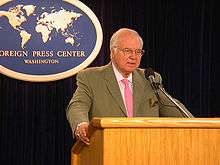
Stanford did not employ a full-time professor in religion until 1951 and did not establish a religious studies department until 1973, later than most other universities in the U.S. Earlier courses in religion were largely offered by the chaplains of Stanford Memorial Church. David Charles Gardner offered a course in Biblical history and literature beginning in 1907, and by 1910, he was teaching New Testament Greek and Bible classes. Gardner's successor, D. Elton Trueblood, taught classes about the philosophy of religion. In 1941 Trueblood's efforts to expand the study of religion resulted in the creation of a minor in religion, as well as twenty-one courses offered by him and four faculty members. By 1960, the chaplains of Stanford Memorial Church no longer had to run the program, which had expanded to allow students the option of majoring in the study of religion.[33] By the mid-1960s, the religious studies program at Stanford was enjoying "enormous success".[34]
In the 1960s, the study of religion at Stanford focused not on academics, but on social and ethical issues like race and the Vietnam War. Leading this focus was Stanford Memorial Church Dean of the Chapel and Professor of Religion B. Davie Napier, who was "a powerful critic of U.S. policy in Vietnam".[6] Napier, along with Stanford professors Michael Novak and Robert McAfee Brown, who had previously been faculty members of seminaries, were the subject of a Time Magazine article in 1966, describing "the renaissance of faith and learning at Stanford".[6] Students crowded into the church to hear anti-war speeches by them, as well as by "notables" such as Linus Pauling and William Sloan Coffin.[24] Harvey credited Napier for making the church a popular meeting place on campus for undergraduates and for turning it into "Christian theater—the introduction of jazz and other types of experimental worship as well as provocative preaching".[6] Stanford University was the first major educational institution in the United States that conducted same-sex commitment ceremonies at its chapel.[35] Its first ceremony was held in 1993, and was officiated by Associate Dean Diana Akiyama.[36]
Chaplains
Stanford Memorial Church, throughout its history, has been served by chaplains who have been influential amongst the Stanford University student body and community at large. R. Heber Newton, "distinguished writer"[37] and former rector at All Souls Church in New York, was handpicked by Jane Stanford to serve as the church's first pastor; he resigned after four months in 1903 "because he disagreed with Mrs. Stanford on some aspects of church management".[38] According to Stanford biographer Robert W. P. Cutler, "Newton's tenure had been a disappointment to Mrs. Stanford".[39] David Charles Gardner, who replaced Newton, served the church from 1902 to his retirement in 1936.[40] Stanford also handpicked Gardner as Newton's assistant because she was impressed with his "parish work" in Palo Alto.[37] Gardner went on to teach courses in Biblical history and literature at Stanford.[40] Influential English professor and Stanford historian Edith Mirrielees[41] called Gardner "a preacher of only indifferent ability", but considered him "a strength to the whole university". According to her he was the prime mover behind the creation of the Stanford Home for Convalescent Children,[42] established in 1919, which eventually became the Lucile Packard Children's Hospital.
D. Elton Trueblood, a lifelong Quaker, was the church's chaplain from 1936 to 1946.[38] Trueblood was also a professor of philosophy of religion at Stanford and established the university's first major in religious studies;[43] his tenure there provided him with national exposure.[44] He wrote 33 books, including one about Abraham Lincoln. Trueblood and his wife hosted monthly Friends meetings in their home, and met weekly with Orthodox Jewish students in the vestry of Stanford Memorial Church.[38][44][45] George J. Hall was the church's chaplain from 1946 to 1947, followed by Paul C. Johnson, who served between 1949 and 1950. Robert M. Minto was chaplain twice, in 1947-1948, and again from 1950-1973.[38] Minto, an associate chaplain at Stanford for two years prior, was a pastor in Scotland and a former British naval chaplain during World War II.[46]
Stanford's next two chaplains, B. Davie Napier (Dean of the Chapel, 1966–72)[47] and Robert McAfee Brown (Acting Dean of the Chapel, 1972–73),[38] were among the most politically active chaplains. Napier was an ordained Congregational minister. He was born in China to missionary parents, grew up in the American South, and went to seminary at Yale. He gained fame among Stanford students "for his efforts to relate Scripture to the turbulent political times of the late 1960s".[47] Napier was a "charismatic biblical scholar ... [and] a powerful critic of U.S. policy in Vietnam".[6] Napier was also a "gifted" preacher and jazz pianist.[6] Brown, the author of 29 books, became "an international leader in civil rights, ecumenical and social justice causes".[48] He also protested U.S. involvement in Vietnam and taught religion and ethics in relation to contemporary life and literature.[48]
Robert Hamerton-Kelly (1972–86), born in South Africa, was a United Methodist minister. He taught religion, classics, and Greek at Stanford.[49] Thomas Ambrogi was the acting dean in 1986.[38] He was a former Jesuit priest who was an elder in the First Presbyterian Church in Palo Alto, and referred to himself as "a transdenominational Christian with roots in the Catholic tradition".[50] Robert C. Gregg (1987–98) was born in Texas and ordained as an Episcopal priest. He was also Professor of Religious Studies.[51][note 3] Kelly Denton-Borhaug (1999–2000), a Lutheran minister, came to Stanford in 1996 as an associate dean.[52][53] The Rev. Scotty McLennan (2001-2014), a Unitarian Universalist minister, was "an activist neighborhood lawyer"[54] in Boston before becoming a university chaplain, first at Tufts University.[54] Garry Trudeau, who was McLennan's roommate when they were students at Yale University, based his Doonesbury character, the Rev. Scot Sloan, in part on McLennan.[54] He was replaced by a British historian and Anglican priest, the Very Rev. Jane Shaw in September 2014.
Staff
Stanford Memorial Church is run by the Stanford Office for Religious Life, headed by the Dean for Religious Life.[55] The Very Rev. Prof. Jane Shaw is Dean for Religious Life at Stanford.[56] The dean, along with senior associate dean, Rabbi Patricia Karlin-Neumann, and associate dean, the Rev. Joanne Sanders, oversee educational programs and serve on administrative committees on campus.[57]
Jane Shaw is an historian, Anglican priest, and professor in the Religious Studies Department at Stanford. Educated at Oxford University, Harvard University, and the University of California, Berkeley, she came to Stanford in 2014 from being Dean of Grace Cathedral, San Francisco, and from teaching history at Oxford University for sixteen years.
Rabbi Karlin-Neumann is Stanford's first Jewish associate dean of religious life. Before the university hired her in 1996, the chaplaincy position was called "Dean of Memorial Church"; in order to accommodate Karlin-Neumann, the position's name was changed to "Dean of Religious Life at Stanford".[58] Before coming to Stanford, Karlin-Neumann had been a Hillel director and chaplain at UCLA and Claremont College, a rabbi in Alameda, California, and was active in Reform Judaism. She has taught courses in Jewish feminism, rabbinical ethics, education, and social justice.[59] She refers to her role at Stanford as "Mem Chu and a Jew, too".[58]
Joanne Sanders, an Episcopal priest, has worked at Stanford since 2001. She has degrees in theology, sports administration and physical education. Her career has focused on the connection between body, mind, and spirit. She serves as liturgical officer for Memorial Church, is responsible for coordinating and facilitating the religious services at the church, and is active in the athletic community on campus. She is also a member of Stanford's Women's Community Center.[60]
Robert Huw Morgan has been Stanford Memorial Church's organist since 1999.[61] He is a lecturer in organ at the Stanford University School of Music.[62] Morgan performs at up to thirty services, mostly weddings, each month at the church.[61] Melissa Prestinario is the wedding coordinator at Stanford Memorial Church.[63]
Architecture

Stanford Memorial Church was built during the American Renaissance period, a time of architectural eclecticism, so elements of styles from different eras are synthesized in its design.[64] The architectural style of Stanford Memorial Church has been referred to as "a stunning example of late Victorian ecclesiastical art and architecture with echoes of Pre-Raphaelitism".[65] As it stands today, having been altered after earthquake damage, Stanford Memorial Church has the plan and structure of a large Romanesque church while the extensive use of mosaic and the foliate forms of the stone carvings reflect Byzantine styles seen by Jane Stanford on her visits to the churches of Constantinople and St Mark's Basilica in Venice.[66]
Charles A. Coolidge, a protégé of Henry Hobson Richardson, was the church's architect; he also developed the massing of Richardson's Trinity Church in Boston in 1876.[7] Like Trinity Church, Memorial Church originally had a large central tower with turrets and a twelve-sided spire, but this was lost as a result of the 1906 earthquake.[20] The church's blueprints were prepared by Clinton E. Day of San Francisco, and Charles E. Hodges was the supervising architect for the project. Jane Stanford hired builder John McGilvray, who was responsible for constructing the St. Francis Hotel, the City Hall complex in San Francisco, and much of Stanford University, for the actual construction of Stanford Memorial Church.[8]
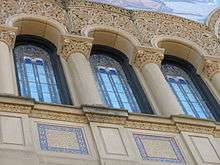
Jane Stanford's taste and knowledge of both contemporary and classical art is evident in several aspects of the plan, appearance, and architecture of the church, which "dazzle the eye yet also produce an atmosphere of quiet contemplation".[65] On her direction, Coolidge imitated the "glorious color"[67] of the European cathedrals, especially those in Italy. Although the iconography in the church is Christian, Stanford was a "late Victorian progressive",[65] and chose the art less for its religious themes and more for its "humanitarian ethics".[65] She requested that the designs include women, "to show the uplifting influence of religion for women";[68] there are many women depicted in the 24 mosaics throughout the church.[68] Art historian Judy Oberhausen reports that Stanford used compendium of biblical illustrations like The Story of the Bible by Charles Foster, which contained 300 illustrations and summarized the events and stories she wished to depict in the church's windows and mosaics.[65]
Jane Stanford's design included inspirational messages placed throughout the church in the form of inscriptions carved into its walls and enclosed in carved frameworks.[69] As Barbara Palmer of the Stanford Report stated, Stanford "had her religious beliefs literally carved into the church's sandstone walls".[13] For example, the following quotations can be found in the church's east transept:[note 4]
Religion is intended as a comfort, a solace, a necessity to the soul's welfare; and whichever form of religion furnishes the greatest comfort, the greatest solace, it is the form which should be adopted be its name what it will.
The best form of religion is trust in God, and a firm belief in the immortality of the soul, life everlasting.[70]
Plan

The church is a cruciform structure measuring 190 feet (58 m) long and 150 feet (46 m) wide, which originally included the clock and bell tower with an 80-foot (24 m) spire.[12] The facade faces the Inner Quad, and is connected to other buildings by arcades which extend laterally. The entry is through a narthex or vestibule extending across the building. The nave has a single aisle on either side, separated by an arcade with a clerestory above it. The crossing is formed by a structure of square plan which once supported the central tower. Over it is a shallow dome supported on pendentives and rising to a skylit oculus. High semicircular Romanesque arches separate the crossing from the nave, transepts and chancel. The chancel and transepts are apsidal. There are deep galleries with concave balustraded fronts in the transepts and an organ gallery above the narthex. The sanctuary, in the chancel, is elevated and approached by steps.
Exterior
The chief building material of the church is buff sandstone, which came from the Goodrich Quarry (also called the Greystone Quarry[71]) in the Almaden area of San Jose, was delivered by train and rough-cut in the university Quad.[72] It is roofed with terracotta tiles of the Italian imbrex and tegula form. The nave, chancel and transepts appear to project from the robust square central structure which is now roofed with tiles and has a small skylight above its center.
The ornate facade is divided into two zones with a gable roof of low pitch surmounted by a Celtic cross.[73] In the lower zone, there are three arched entrances; the central one is slightly larger than the others. The surrounding stonework is intricately carved with stylized flora, twisted-cable moldings, and bosses of sculpted cherubim, a motif which occurs in different media throughout the church. In the spandrels are mosaic depictions of the biblical concepts of love, faith, hope and charity intertwined in a vine representing the "tree of life".[note 5]
In the upper zone of the facade, surrounded by more elaborate stonework, is a large central window, with groups of three smaller windows on each side. The original central window was a quatrefoil-shaped rose window, but after the 1906 earthquake, it was replaced by a "classical round-head window that more grandly restates the smaller flanking, articulated openings"[67] and that corresponded with the mission-style architecture of the Quad.[26] Beneath the windows are inlaid panels of colored marble.
The gable and surrounding surfaces contain the church's largest mosaic, created by Paoletti, and recreated by him after the 1906 earthquake. Measuring 84 feet (26 m) wide at the base and 30 feet (9.1 m) in height, at the time of its completion, it was the largest mosaic in the U.S. It depicts a group of men, women and children, 47 in all, surrounding and "paying close heed"[74] to Christ, the mosaic's central figure. Paoletti included a landscape with "waving palms and a gleaming sky"[74] behind Christ.
After Jane Stanford's death, the mosaic popularly gained the name "The Sermon on the Mount", although Stanford University historian Richard Joncas insists that the mosaic does not depict the scene as described in the Gospel of Matthew and has referred to it simply as "an indefinite biblical scene".[67] In the Stanford University press release about the gift of watercolor cartoons for the church's mosaics, Paoletti's design for the facade is described as "Christ Welcoming the Righteous into the Kingdom of God", based on Matthew 25:34.[66] Paoletti created another unfinished watercolor depicting "The Last Judgment", as another option for the facade mosaic, but it was evidently rejected by Stanford.[13]

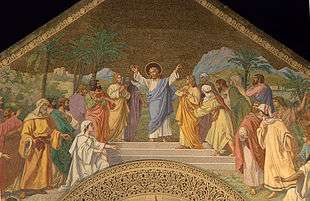
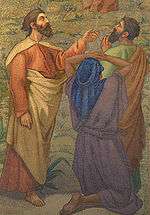
Interior
Jane Stanford has been described as having a "Victorian aversion to blank space"[75] and so created a church that is "a dimly lit cavern of glowing mosaic surfaces ... and vibrant, stained-glass windows".[67] The church is richly decorated throughout, its architectural features carved with formalized foliate ornament, and the walls adorned with mosaics in the Byzantine manner.[9] The stained-glass windows were crafted by J. and R. Lamb of New York.[76] The chandeliers, installed in 1915, are in the Art Nouveau tradition and have gold decorative patterns cast in pot metal.
The church is entered through three bronze doors adorned with angels, a recurring motif throughout the church. The doors open up into a narthex or vestibule decorated with mosaics on the walls and stone carvings on the architectural details. There is a variety of styles and motifs reflecting the hands of different craftsmen. The mosaic that adorns the floor depicts the Lamb of God surrounded by the symbols of the four gospel writers: St. Matthew (the winged angel), St. Mark (the winged lion), St. Luke (the ox), and St. John (the eagle). These symbols also appear in other areas of the church.[77] A Celtic cross adorns the central wooden door that leads into the nave, and Latin epigraphs have been engraved above the two side doors.[78]
Above the narthex is an organ gallery. The nave is arcaded and has a single aisle on each side with clerestory windows above. The exposed timber ceiling was inspired by Trinity Church and is constructed with tied hammer beams, which can be seen radiating in the chancel. The floor of the church slopes downward towards the crossing.[67] The chancel and transepts are three semi-circular apses.[67] They are separated from the broad central space by large semi-circular arches on stout columns with carved capitals. The transept apses each have a balcony with a concave balustrade.
Directly above the crossing is a dome supported on pendentives. Around the base of the dome are decorative gilt bands, the lower depicting a scrolling vine. Jane Stanford intended the dome's decoration of to be of mosaic tiles showing a variety of symbols, but the church's builders thought it would make the dome too heavy, so the decorations were painted. On the spandrels of the pendentives are mosaics of four angels measuring 42 feet (13 m) from wing tip to wing tip, rising from clouds. The angels survived the 1906 earthquake, but the angel looking downward was severely damaged during the 1989 earthquake because an 8-foot section of its left wing fell 70 feet (21 m).[79]
The chancel, according to Hall, contains "artistic work of a kind seldom seen anywhere".[74] The raised tiled floor of the chancel curves outward into the body of the church, and is approached by seven marble steps. The sanctuary is raised further, and enclosed by a marble altar rail behind which is an altar carved from white Carrara marble by L.M. Avenali. The altar supports a "simple unadorned brass cross that reflects the colors of the mosaics surrounding it."[80] The cross was made by William van Erp and was dedicated to the memory of Jane Stanford in 1948.
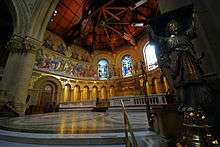
Behind the altar is a mosaic reproduction of Roselli's "Last Supper". Around the lower walls of the chancel are twelve niches decorated with golden mosaic tiles. They hold candles, but originally held statues of the twelve apostles, destroyed in 1906 and were never replaced. According to local legend, the cherubim carved in stone above the golden niches and in the pillars' capitals are illustrations of children living on campus at the time of the church's construction.[80] To the west side of the chancel stands brass lectern in the form of a reading angel, which Jane Stanford brought from Europe and dedicated to her husband on the anniversary of his birth in 1902.[81]
Three stained glass windows in the apse depict the nativity, crucifixion, and ascension of Christ. The mosaics between them show angels, those on the left carrying a cross, those on the right carrying a crown. On the longer sections of the chancel wall, on either side of the windows, are mosaics depicting a choir of angels. Above them is a tier of mosaics with representations of the prophets and kings of Israel. Other mosaics abound in the transepts, clerestory, and the choir loft at the northern end of the church. A series of mosaics in the upper transepts depict Old Testament figures on the east side and Christian saints on the west side. On Jane Stanford's direction, they alternate male and female.[75]
The arches, balcony rails, and pillars throughout the church have relief carvings created by a team of 10 men who worked for two years from scaffolding.[82] A large double pillar before the entrance of the west transept have inscriptions dedicated to members of the Stanford family. After the 1989 earthquake, a third of the west transept was converted into a small chapel. The altar and chairs in this chapel were designed by Bay Area artist Gail Fredell who decorated the chapel's altar by using Salvatti's original mosaics, which had been stored since the church's reconstruction following the 1906 earthquake.[83]
Windows
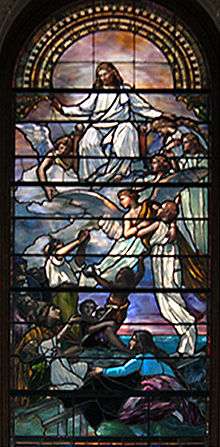
According to architectural historian Willis L. Hall, the church's 20 large stained glass windows "are as much a feature of the church as the mosaics".[76] The windows, designed by Frederick Stymetz Lamb (1863–1928) and fabricated by J&R Lamb Studios, his father's firm in New York City, took three years to complete,[9] and eight months to install at Stanford.[84] Jane Stanford hired Lamb because she felt he was more interested in "the ecclesiastical rather than commercial aspect of the work".[85] The installation of the windows at Stanford Memorial Church was the largest enterprise of its kind at the time, and the project is considered one of the best examples of Lamb's work.[72] Stanford chose the life of Christ for the windows' theme, inspired by the religious paintings by European master painters such as Shields and Doré. Her personal touch is shown in one of the nave windows, which is based on a cartoon by Paoletti and depicts Christ welcoming the soul of a child into Heaven before the eyes of its grieving mother, an allusion to the death of Leland Stanford, Jr.,[9] the Stanfords' only child and the university's namesake, who died in 1884 of typhoid shortly before his 16th birthday.
Oberhausen, who has studied the source of the mosaics and windows, states that at least four stained glass windows were inspired by the paintings of Pre-Raphaelite artists that were enjoying a resurgence in popularity at the time. These windows are: "Christ in the Temple" in the east transept, based upon a painting by William Holman Hunt; "The Annunciation" in the east nave, inspired by a work by Frederic Shields; "The Nativity" in the chancel, based upon a painting by Edward Fellowes-Prynne; and "The Good Shepherd" in the west transept, inspired by a painting by Sibyl C. Parker, the only female artist represented in the artwork of the church.[65] None of the windows of Stanford Memorial Church required replacement after the 1906 quake, except for "the famous rose window of the original structure" in the organ loft which was replaced by the current large, central arch window.[76] This window, entitled "Lilies of the Field", is the only window in the church that cannot be viewed from the inside because it is blocked off by the central organ.[64] There is a cross in the center of this window made of "faceted pieces of glass that are inset like gems",[64] which sparkle when light strikes it.
The church's clerestory contains many smaller windows of individuals from the Bible or Christian history. The windows in the nave above the east arcade depict the following Old Testament figures: Abraham, Hagar and her child Ishmael, Moses, Pharaoh's Daughter, Joshua, and Deborah. The windows in the east transept depict David, Ruth, Solomon, The Queen of Sheba, Elijah, Esther, Isaiah, Judith, Daniel, and Hannah. In the nave above the west arcade feature saints and virtues: Stephen, Agnes, Peter, Priscilla, John, and Hope. In the west transept are Simeon, Anne, Matthew, Faith, Mark, Charity, Luke, Dorcas, Paul, and Martha. The clerestory above the east and west doors are two windows of angels. Unlike the other windows throughout the church, they do not receive natural light from outside and are artificially illuminated instead.

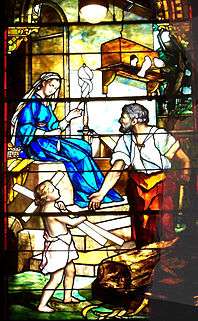
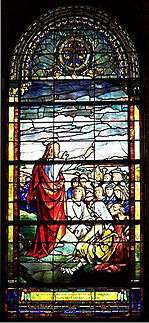

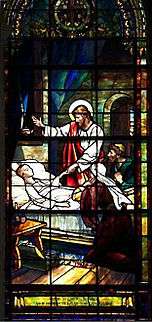
|
|
|
|
| Title | Inspired by |
|---|---|
| "The Nativity" | Edward Fellowes-Prynne |
| "The Crucifixion" | Ernst Deger |
| The Ascension | Johann Karl Loth ("Carlotto")[note 8] |
Mosaics

The mosaic project began in 1900 and took five years to complete.[8] Jane Stanford chose mosaics to decorate her church because of the similar weather in Italy and Northern California, where the moderate climates and rainy seasons in both settings protect the images from erosion and clear the pollution that accumulates on many buildings in large cities. As Hall states, the "mosaics on the facade are always clear and brilliant."[86] Their "shimmering quality" was created by different tones of green and gold;[77] the artists that installed the mosaics had over 20,000 shades of colors to choose from.[87] The images cost US$97,000,[9][note 9] and were based upon original watercolors created by artist Antonio Paoletti.[note 10] Jane Stanford worked closely with Paoletti, planning a combination of Old Testament and New Testament scenes that represented men and women equally. After Stanford approved Paoletti's designs, full-sized images were created as patterns, and then divided into two-foot-square sections, which were made into glass by other artists. The mosaics were made in Venice, shipped by boat in pieces to New York and then by railroad to California, where they were placed on the church's walls.[13][note 11]
The mosaic adorning the church's chancel is a reproduction of Roselli's fresco of the Last Supper from the Sistine Chapel in the Vatican. Camerino obtained permission from Pope Leo XIII to reproduce it at Stanford Memorial Church.[8] Unlike other works, which were reproduced frequently, it was the only reproduction of Roselli's fresco at the time.[88] Artisan Lorenzo Zampato was given the task of supervising the in-studio fabrication and final installation at Stanford. There are 12 mosaics in each transept balcony that are split into two sets of six, creating an arc of six mosaics, ten windows, and six mosaics. Most of the church's mosaics were made from 1/8-inch tiles; larger 3/4-inch tiles were used on the higher mosaics, and smaller 1/4-inch tiles were used in "The Last Supper" mosaic.[87] Mosaics are "virtually everywhere" inside the church and have been described as "a perfect complement to Frederick Lamb's stained-glass windows".[note 12][8]
| Title(s) | Location |
|---|---|
| "Christ Welcoming the Righteous into the Kingdom of God"[note 13] | Outside facade |
| Love, Faith, Hope, and Charity mosaics | Below facade, between windows |
| Monogram medallions[note 14] | Vestibule |
| Two cherub groups[note 15] | In the frieze over the doors from the vestibule to the nave |
| "Our Lord on His Throne Surrounded by the Four Evangelists, Apostles, Kings and Friends" | Under the organ loft and over the doors |
| "The Prayer of Hannah", "Ahasuerus Selects Esther to be his Queen", "The Judgment of Solomon", "Saul Casts His Spear at David", "God's Promise to Solomon when Building the Temple" | East Nave, under the arches of the east wall |
| "The Garden of Eden"[note 16] | East door, near the pilaster |
| "God Separating Light from Darkness", "The First Family",[89] "The Deluge", "The Tower of Babel", "Moses Saved From the Water" | East clerestory over the arches |
| "Noah is Ordered to Build the Ark", "Abraham is Informed He Will Have a Son", "Abraham Sees the Promised Land", "Angel Gabriel Announces to Zacharias the Conception of John the Baptist", "Daniel's Prophecy" | East clerestory between the windows |
| "Last Supper", "Seraph Choir"[note 17] | The wall of the chancel |
| "John the Baptist", "Ezekiel", "Samuel", "Jeremiah" | Above the east apse |
| "David", "Elijah", "Moses", "Isaiah" | Above the west apse |
| The four archangels emerging from clouds.[note 18] | Over the four pilasters supporting the dome |
| Spandrels decorated in mosaic | Dome ceiling |
| Child's face[note 19] | Triangular area in front of dome |
| "Rebekah and Isaac", "Rachel Sees Jacob Approaching", "Moses is Ordered to take Israel out of Egypt", "Moses Sees the Promised Land", "Joshua finds a Captain for His Hosts" | Starting at the church entrance, the west wall of the nave, between the windows [83] |
| "Old Testament Prophecies Concerning the Coming of Christ" | Over the west door, near the pilaster |
| "Moses Receiving the Tablets of the Law", "Joshua Successor of Moses", "David Anointed for the First Time", "Meeting of David and Abigail", "David Singing His Psalms" | West clerestory, over the arches |
| "Joseph Sold by His Brothers", "Jacob Going to Canaan", "Isaac Blessing Jacob", "Dream of Jacob", "Abraham Restrained From offering up Isaac" | West clerestory between windows |
| "Noah", "Noah's Wife", "Isaac", "Rebecca", "Jacob", "Rachel", "Tobias", "Sarah (Tobias's wife)", "Nathan", "Deborah", "Aaron", "Naomi"[note 20] | East Transept Gallery wall |
| "St. Helena", "St. James", St. Margaret", "St. Andrew", "St. Philemon", "St. Thaddeus", "St. Elizabeth", "St. Bartholomew", "St. Mary Magdalene", "St. Barnabas", "St. Gertrude", "St. Philip"[note 21] | West Transept Gallery wall |
Organs
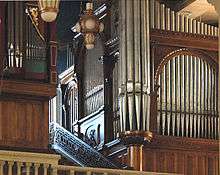
Stanford Memorial Church houses five organs, a "situation only a few places in the nation can boast",[61] since most churches only have one. The presence of multiple and high-quality organs makes Stanford an ideal location for accomplished musicians, and the sanctuary one of California's best settings for instrumental and choral performance.[90] The church's organist is Robert Huw Morgan.[61]
Stanford Memorial Church's original organ is still in use. It was built by Murray M. Harris in 1901 and sits in the upstairs galley. In 1915, an echo division with eight ranks of pipes was added.[91] Damaged in the 1906 earthquake, the organ was rebuilt in 1925, enlarged in 1933, and thoroughly restored in 1996. It features three manuals (keyboards for the hands), 57 stops, and over 3,700 pipes.[8][92] Morgan compares the Murray-Harris organ to a Rolls Royce and its successor, the Fisk-Nanney organ, to a Maserati.[93]
The largest organ is the Fisk-Nanney organ, built in 1985 by the C. B. Fisk company and described by Morgan as "a desperately famous instrument".[93] It is named after its designer, Charles Fisk, and for Herbert Nanney, who was the church's organist for 39 years.[61] The Fisk-Nanney organ was commissioned in 1973, when the church received a special endowment. Its completion was delayed for over 25 years due to logistical and financial problems. In order to accommodate the organ's weight, the choir loft had to be rebuilt and reinforced.[92]

The Fisk-Nanney is a four-manual instrument with 73 ranks and almost 4,500 pipes composed of various alloys of tin and lead. It uses a "combination of elements from historic East German, North German, and French organs plus dual temperaments",[92] and is the only organ in the church capable of authentically reproducing nearly all organ music written from the 16th through the 18th centuries.[92] The organ features both French- and German-style reeds and principal choruses. It is equipped with a Brustpositiv division in meantone temperament that offers two split keys per octave (D-sharp/E-flat and G-sharp/A-flat). A lever allows the remaining divisions to alternate between well temperament and meantone temperament, a feature made possible by the inclusion of five extra pipes (two for each sharp key) per octave.[92] The organ's case is made of poplar and the keyboards are fashioned from grenadilla. The naturals and sharps are rosewood capped with bone.
Morgan describes the organ as ringing with "'incredible clarity' and 'dark color'".[93] It is able to "reproduce the sound of Baroque music as authentically as possible".[92] In 2005 Morgan performed the complete organ works of Dieterich Buxtehude during a series of recitals, eight hours in all, to celebrate the organ's 20th anniversary. During the 2009–2010 season, Morgan commemorated the 25th anniversary of the Fisk-Nanney organ and his 10th year at Stanford in a concert series of the complete organ works of Johann Sebastian Bach, which took 18 hours to complete.[93]
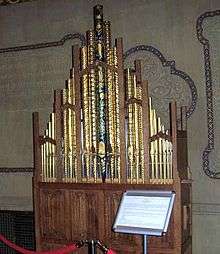
The side chapel houses the Katherine Potter-Brinegar organ, a one-manual Renaissance-style instrument built by Paul Fritts and modeled after the work of the 17th-century German organbuilder Esias Compenius.[92] Built in 1995, it "further enhances"[92] the diversity of the church's musical capacity. It has eight stops, of which three are reeds. The majority of its pipework is made of wood. The organ can be moved easily to different locations in the building with the aid of hidden retractable wheels.[92]
The continuo organ built by Martin Pasi of Roy, Washington was acquired in June 2001. It contains three stops. The case and most of its pipes are made of walnut, and the keys are made of English boxwood and ebony.[4]
In 2010 the church received on long-term loan a five-rank Tudor-style organ built by Hupalo and Repasky Pipe Organs. It is a recreation based upon the work of Martin Goetze and Dominic Gwynn of Nottinghamshire, England and the finding in 1995 of a few pieces of a Tudor organ. Few English organ survives from the sixteenth century and this is one of only two five-rank Tudor-style organs in the world.[94]
Services and facilities
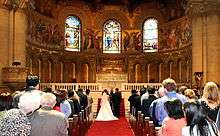
Although the Stanfords were religious and viewed "spiritual and moral values as essential to a young person's education and future citizenship", they were not formally committed to any Christian denomination.[3] As a result, Jane Stanford decreed, from the beginning of Stanford Memorial Church's history, that the church be non-denominational. She believed that adopting this philosophy would "serve the broadest spiritual needs of the university community".[3] The church's first chaplain, Charles Gardner, declared on the day of its dedication that the church's goal was to serve the spiritual needs of the university in a non-sectarian way.[3] The Stanfords' goal was that moral instruction would occur at the church, as demonstrated in the inscriptions carved into its walls, which was influenced by the late 19th-century liberal Protestantism they embraced.[95] As former Stanford chaplain Robert C. Gregg states, "The Stanfords sought to protect free intellectual inquiry—in classroom, laboratory, and church—from any interference prompted by the caution or dogmatism of religious authorities".[96]
Stanford Memorial Church was the earliest interdenominational church on the west coast of the U.S. and has remained "among the most prominent".[4] Multi-faith services are held at Stanford Memorial Church, in addition to denominational and non-denominational Christian services. As many as 150 weddings take place in the church each year[24] as well as many memorial services for people affiliated with the university.[63][97] Members of the university community use it for "quiet, for reflection, and for private devotions".[95] The church also hosts frequent musical performances from Stanford's own choirs and orchestra, as well as visiting groups such as the vocal ensemble Chanticleer.[98] Catholic masses are held in the church several times a week. Offertories at the principal Sunday services are donated to local charitable organizations.[4]
See also
Footnotes
- ↑ The Stanfords built the university, which opened in 1891, to honor their only child, Leland Stanford, Jr., who died in 1884 of typhoid shortly before his sixteenth birthday. A church had been envisioned but not started when the senior Leland Stanford died in 1893.
- ↑ William Kreysler described the repair in detail in Flash Point Magazine in 2013.[28]
- ↑ Gregg also wrote Glory of Angels, the 1995 book about MemChu.
- ↑ For a complete list of the inscriptions, see Hall pp. 39–45.
- ↑ Love is represented by a mother with wings encircling children.
- ↑ Lamb created "subtle shadows" in the angel's robe by using layers of colored glass and white glass. He also created a luminescent effect by setting the angel against a dark background.
- ↑ The best time to view these windows is in the early morning.
- ↑ Carlotto's painting was in turn probably inspired by Raphael's painting of the Transfiguration of Christ.
- ↑ This figure is the equivalent of almost US$2 million in 2002.
- ↑ Salviati & Company also designed and built eight large mosaics in Stanford's museum and decorated the vestibuile of the university's mausoleum.
- ↑ After the mosaics were destroyed in the 1906 earthquake, they were able to be recreated because the original designs had been stored in the Salviati & Company studios.
- ↑ List taken from Hall, pp. 31–33
- ↑ Commonly known as "The Sermon on the Mount"
- ↑ Forms the Greek letters alpha and omega and Christ's initials (Chi Rho).
- ↑ Cherubs holding tablets with the inscriptions, Domus Dei Locus Orations ("The House of God, the place of prayer") and Domus Dei Aula Coeli ("The House of God, the forecourt of heaven").
- ↑ This mosaic measures 12 feet (3.7 m) by 15 feet (4.6 m).
- ↑ Also called "The Glory of the Angels".
- ↑ The ceiling of the dome is decorated in mosaic, a notable feature being a frieze containing a large number of medallions.
- ↑ This is the hidden mosaic in the church, and one of two mosaics to survive the 1906 earthquake.
- ↑ The lunettes over the doors are decorated with cherub singers and the remainder of the wall has tapestry mosaic work in a variety of colors.
- ↑ The lunettes of the doorways and the walls are decorated with tapestry mosaic work.
Notes
- ↑ Nguyen, Ivy; Najarro, Ileana (17 October 2011). "Jobs honored at MemChu service". The Stanford Daily. Retrieved 12 December 2015.
- ↑ Gregg, p. 34
- 1 2 3 4 5 "About Memorial Church". Office for Religious Life. Stanford University. Retrieved 27 January 2016.
- 1 2 3 4 "Stanford University: Memorial Church" (PDF). The Office for Religious Life. Stanford University. Retrieved 27 January 2016.
- 1 2 3 4 5 Harvey, p. 3
- 1 2 3 4 5 6 7 Harvey, p. 7
- 1 2 3 Joncas, p. 27
- 1 2 3 4 5 6 7 8 9 10 11 12 13 14 Taylor, Joseph A. "Memorial Church History Overview". The Office for Religious Life at Stanford University. Retrieved 27 January 2016.
- 1 2 3 4 5 6 Barr, Sheldon (September 2002). "Venetian Glass at Stanford University". Magazine Antiques.
- 1 2 Davis, p. 36
- ↑ Gregg, p. 17
- 1 2 3 Hall, p. 21
- 1 2 3 4 Palmer, Barbara (23 February 2004). "Mosaic Exhibit Shows Rejected Design for Memorial Church". Stanford Report. Retrieved 12 February 2016.
- 1 2 Gregg, p. 11
- 1 2 3 4 "Stanford Memorial Church Dedicated Yesterday with Impressive Ceremonies". San Francisco Chronicle. 26 January 1903.
- ↑ Oberhausen, p. 4
- ↑ "Obituary Jane Stanford". The New York Times. 25 March 1905. p. 9.
- 1 2 3 Hall, p. 22
- ↑ Gregg, p. 24
- 1 2 3 4 5 6 "Repair of Monuments 4: Memorial Church". Quake '06 Walking Tour. Retrieved 19 February 2016.
- ↑ Gregg, pp. 25, 28
- 1 2 3 Gregg, p. 25
- ↑ Palmer, Barbara (13 July 2001). "His Ph.D. Beckoning, Clock Tower Caretaker Winding Down His Volunteer Duties". Stanford Report. Retrieved 19 February 2016.
- 1 2 3 4 5 Gregg, p. 29
- ↑ Junkerman, Charles (Fall 2010). "A Biography of Stanford Sandstone: From Greystone Quarry to Stone River" (PDF). Sandstone & Tile. 34 (3): 10. Retrieved 19 February 2016.
- 1 2 3 4 5 Gregg, p. 26
- 1 2 3 Gregg, p. 30
- 1 2 3 Kreysler, William. "In Defiance of Gravity: The Restoration of Stanford's Angels". Flash Point. 6 (2). Archived from the original on 3 August 2013. Retrieved 27 March 2016.
- ↑ Gregg, pp. 38–39
- ↑ Gregg, p. 31
- ↑ Harvey, pp. 3—4
- ↑ Bartholomew, Karen; Claude Brinegar; Roxanne Nilan (2001). A Chronology of Stanford University and Its Founders. Stanford, Calif.: Stanford Historical Society. p. 90. ISBN 0-9664249-1-3.
- ↑ Harvey, pp. 4—6
- ↑ Harvey, p. 6
- ↑ Honan, William H. (22 July 1997). "Harvard Allows Gay Couples to Hold Ceremonies at Its Chapel". The New York Times. Retrieved 17 April 2016.
- ↑ Chaung, Angie (18 October 1993). "A First for Mem Chu" (Volume 204, Issue 16). Stanford Daily. p. 1. Retrieved 17 April 2016.
- 1 2 Elliott, Orrin Leslie (1937). Stanford University: The First Twenty-five Years. Stanford, California: Stanford University Press. p. 140.
- 1 2 3 4 5 6 "Guide to the Stanford University, Memorial Church, Records". Online Archive of California. Retrieved 17 April 2016.
- ↑ Cutler, Robert W.P (2003). The Mysterious Death of Jane Stanford. Stanford, California: Stanford University Press. p. 24. ISBN 0-8047-4793-8.
- 1 2 Hartwig, Daniel. "Guide to the Rev. David Charles Gardner Collection". Stanford University Libraries, Department of Special Collections and University Archives. Online Archives of California. Retrieved 18 April 2016.
- ↑ Grossman, Taylor (7 June 2012). "Steinbeck at Stanford". The Stanford Daily. Retrieved 24 April 2016.
- ↑ Mirrielees, Edith (1959). Stanford: The Story of a University. New York: Putnam. pp. 111, 210–212.
- ↑ Harvey, pp. 3−4
- 1 2 Bolling, Landrum (Winter 1995). "D. Elton Trueblood: 1900 to 1994". Way Net.org. Erlhamite Magazine. Retrieved 24 April 2016.
- ↑ Trueblood, Elton (1979). The Best of Elton Trueblood: An Anthology. Kirkwood, Missouri: Impact Books. p. 84. ISBN 0-914850-86-5.
- ↑ "Minto Given Chaplaincy" (PDF). Standford Daily. 26 September 1950. Retrieved 10 May 2016.
- 1 2 Peña, Michael (2007-02-28). "B. Davie Napier, Dean of Stanford Chapel During Turbulent 1960s, Dead at 91". Stanford News Service. Retrieved 2013-08-09.
- 1 2 Palmer, Barbara (2001-09-07). "Activist Theologian Robert McAfee Brown Dead at 81". Stanford Report. Retrieved 2013-09-24.
- ↑ Gemmet, Andrea (2004-06-16). "Going By the Book: Woodside Village Church Pastor Retires, Returns to Intellectual Pursuits". The Almanac. Retrieved 2013-09-24.
- ↑ Ambrogi, Thomas E. "Leaving Church". A Voice from the Desert. Retrieved 2013-09-24.
- ↑ Ray, Elaine (1997-12-05). "Priestly Passions: Dean Robert Gregg Talks about What's Dear to his Heart". Stanford News Service. Retrieved 2013-09-24.
- ↑ Ray, Elaine (2000-06-19). "University Chaplain at Tufts Named Stanford's Dean for Religious Life". Stanford News Service. Retrieved 2013-09-24.
- ↑ "Interim Dean for Religious Life Sees More Values in Questions Than Answers". Stanford Report. 2000-02-23. Retrieved 2013-09-24.
- 1 2 3 Day, Nancy (July–August 2001). "Cut from a Different Cloth". Stanford Magazine. Retrieved 2013-09-24.
- ↑ "Office for Religious Life". Stanford University. Retrieved 5 October 2014.
- ↑ "Office for Religious Life". Stanford University. Retrieved 5 October 2014.
- ↑ "Office for Religious Life Staff". The Office for Religious Life at Stanford University. Retrieved 2013-09-24.
- 1 2 Strasser, Teresa (1996-05-31). "Alameda Rabbi to be Stanford's First Jewish Chaplain". Jewish News Weekly of Northern California. Retrieved 2013-09-24.
- ↑ "Rabbi Patricia Karlin-Neumann". The Office for Religious Life at Stanford University. Retrieved 2013-09-24.
- ↑ "The Rev. Joanne Sanders". The Office for Religious Life at Stanford University. Retrieved 2013-09-24.
- 1 2 3 4 5 Trevino, Laramie (1999-11-10). "Staff Profile: Morgan on Organ". Stanford News Service. Retrieved 2013-09-24.
- ↑ "Dr. Robert Huw Morgan : University Organist and Memorial Church Choir Director". The Office for Religious Life at Stanford University. Retrieved 2013-09-24.
- 1 2 "Wedding Program at Stanford University" (PDF). The Office for Religious Life at Stanford University. Retrieved 2013-09-24.
- 1 2 3 Gregg, p. 37
- 1 2 3 4 5 6 Oberhausen, p. 3
- 1 2 "Venetian Family Donates Historic Watercolors of Church Mosaics" (Press release). Stanford University. 1992-03-03. Retrieved 2013-09-25.
- 1 2 3 4 5 6 Joncas, p. 28
- 1 2 Hall, p. 23
- ↑ Hall, p. 39
- ↑ Hall, p. 40
- ↑ "Santa Clara County - List of Stone Quarries, Etc.". Stone Quarries and Beyond. Retrieved 2013-07-10.
- 1 2 Gregg, p. 22
- ↑ Gregg, p. 36
- 1 2 3 Hall, p. 17
- 1 2 Gregg, p. 57
- 1 2 3 Hall, p. 35
- 1 2 Gregg, p. 38
- ↑ Gregg, p. 39
- ↑ Gregg, p. 53
- 1 2 Gregg, p. 50
- ↑ Gregg, p. 46
- ↑ Gregg, p. 58
- 1 2 Gregg, pp. 42–43
- ↑ Gregg, p. 60
- ↑ Gregg, p. 21
- ↑ Hall, p. 19
- 1 2 Gregg, p. 52
- ↑ Hall, p. 32
- ↑ Gregg, p. 61
- ↑ Gregg, p. 8
- ↑ Cross, Angela Kraft (January 2004). "January Organ Crawl" (PDF). SF/AGO Newsletter. San Francisco Chapter, American Guild of Organists. Retrieved 2013-08-25.
- 1 2 3 4 5 6 7 8 9 "Organs". The Office for Religious Life at Stanford University. Retrieved 2008-10-12.
- 1 2 3 4 Wallace, Rebecca (2009-06-05). "Video: 'A Fascinating Machine'". Palo Alto Weekly. Retrieved 2009-08-05.
- ↑ "Tudor Organ". Hupalo & Repasky. Retrieved 2012-12-16.
- 1 2 Gregg, p. 9
- ↑ Gregg, p. 10
- ↑ "Memorial Services". The Office of Religious Life. Retrieved 2009-04-30.
- ↑ Gant, Michael S. (2008-04-28). "Lively Days". Metro Santa Cruz Weekly. Retrieved 2008-11-18.
Bibliography
- Davis, Erik and Michael Rauner (2006). The Visionary State: A Journey through California's Spiritual Landscape. San Francisco, Calif.: Chronicle Books. ISBN 0-8118-4835-3
- Gregg, Robert C., Karen Bartholowmew, & Lesley Bone (1995). Stanford Memorial Church: Glory of Angels. Stanford, Calif.: Stanford Alumni Association. ISBN 0-916318-54-0
- Hall, Willis Lincoln (1917). Stanford Memorial Church: The Mosaics, the Windows, the Inscriptions. Palo Alto, Calif.: Times Publishing Co.
- Harvey, Van (Spring/Summer 1998). "Religious Studies at Stanford: An Historical Sketch". In Sandstone & Tile, Vol. 22, Nos. 2 and 3, pp. 3–10.
- Joncas, Richard, David J. Neuman, and Paul V. Turner (2006). Stanford University. New York: Princeton Architectural Press. ISBN 1-56898-538-X
- Oberhausen, Judy (Spring 2005). "Stanford Memorial Church: A Late Victorian Jewel". In The Pre-Raphaelite Society Newsletter of the United States, No. 10, pp. 3–4.
External links
| Wikimedia Commons has media related to Stanford Memorial Church. |
- Office for Religious Life at Stanford University
- Stanford University Memorial Church Facebook page
- Historic American Buildings Survey
- Stanford University Office for Religious Life About Memorial Church (see link to Memorial Church 360 degree Panoramic Tour at bottom of page)
- Photograph of the Stanford Memorial Church after 1906 San Francisco earthquake from the Lick Observatory Records Digital Archive, UC Santa Cruz Library's Digital Collections
